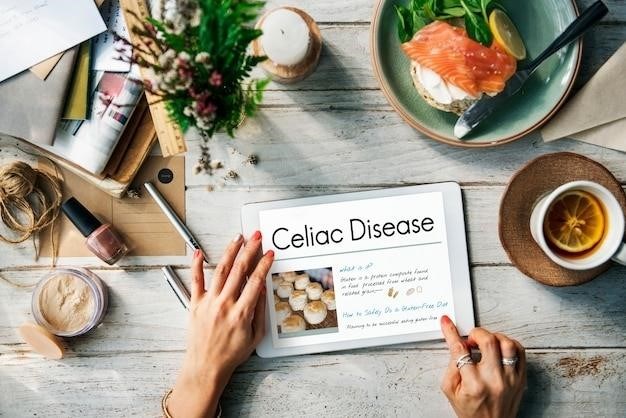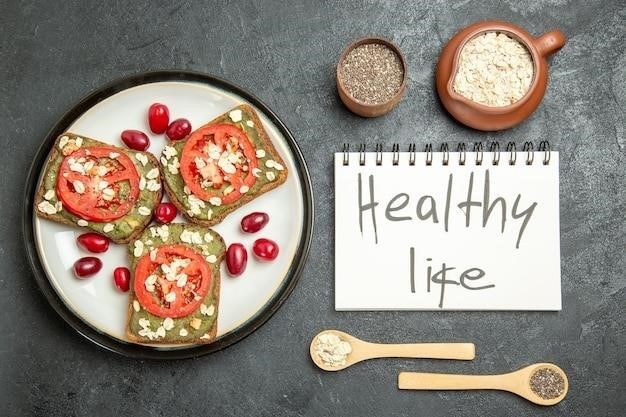Low Histamine Anti-Inflammatory Diet⁚ A Comprehensive Guide
This comprehensive guide provides an in-depth look at the low histamine anti-inflammatory diet, offering a practical approach to managing histamine intolerance and reducing inflammation․

Introduction
Histamine intolerance, a condition characterized by an inability to properly break down histamine, can lead to a variety of unpleasant symptoms, including headaches, skin rashes, digestive issues, and fatigue․ While histamine is a vital compound involved in immune responses and other bodily functions, excessive levels can trigger these symptoms․ A low histamine anti-inflammatory diet is a dietary approach designed to manage histamine intolerance by minimizing histamine intake and promoting anti-inflammatory responses in the body․ This guide provides a comprehensive overview of the low histamine anti-inflammatory diet, covering its benefits, key principles, food recommendations, and tips for success․
Understanding Histamine Intolerance
Histamine intolerance, also known as histamine sensitivity, occurs when the body has difficulty breaking down histamine, a naturally occurring chemical involved in immune responses and other bodily functions․ This can lead to an accumulation of histamine in the body, triggering a range of symptoms․ The exact cause of histamine intolerance is not fully understood, but it may be related to genetic factors, gut health issues, or certain medications․ While some individuals may experience occasional symptoms, others may suffer from chronic histamine intolerance, significantly impacting their quality of life․ Understanding the nature of histamine intolerance is crucial for developing effective management strategies, including dietary interventions like the low histamine anti-inflammatory diet․
Benefits of a Low Histamine Anti-Inflammatory Diet
Beyond managing histamine intolerance, a low histamine anti-inflammatory diet offers a range of benefits for overall health and well-being․ By reducing histamine levels and promoting an anti-inflammatory state, this diet can contribute to improved gut health, reduced allergy symptoms, better sleep quality, and enhanced cognitive function․ The anti-inflammatory effects of this diet can also play a role in mitigating the risk of chronic diseases such as heart disease, arthritis, and some types of cancer․ Additionally, by focusing on nutrient-dense, whole foods, this diet can support healthy weight management, boost energy levels, and improve skin health․ The low histamine anti-inflammatory diet provides a holistic approach to wellness, addressing both histamine-related issues and promoting overall health through dietary interventions․
Key Principles of a Low Histamine Diet
The low histamine diet is guided by a set of key principles designed to minimize histamine accumulation in the body․ This involves limiting the intake of foods high in histamine, those that trigger histamine release, and those that inhibit the breakdown of histamine․ Emphasis is placed on fresh, minimally processed foods while avoiding aged, fermented, or cured items․ The diet emphasizes consuming foods that are naturally low in histamine, such as fresh fruits and vegetables, lean proteins, and gluten-free grains․ Additionally, it encourages the inclusion of anti-inflammatory foods, known for their ability to reduce inflammation and support overall health․ Furthermore, the diet often incorporates strategies to manage stress, as stress can contribute to histamine release․ By adhering to these principles, individuals can work towards reducing histamine levels and mitigating the symptoms of histamine intolerance․
Foods to Avoid
A low histamine anti-inflammatory diet requires careful consideration of foods to avoid, as they can contribute to histamine buildup and exacerbate symptoms․ This category includes high histamine foods, which naturally contain significant amounts of histamine, and histamine-releasing foods, which trigger the release of histamine in the body․ Also included are foods that inhibit histamine breakdown, interfering with the body’s natural process of eliminating histamine․ It’s important to note that this list may vary depending on individual sensitivities and tolerance levels․ However, some common offenders include aged cheeses, fermented foods like sauerkraut and kimchi, processed meats, smoked fish, and certain fruits like citrus fruits and bananas․ Additionally, alcohol, vinegar, and certain spices can also trigger histamine release․ By avoiding these foods, individuals can significantly reduce their histamine intake and manage their symptoms effectively․
High Histamine Foods
High histamine foods are those naturally containing significant amounts of histamine, a compound that can trigger allergic reactions and inflammatory responses in sensitive individuals․ While everyone has histamine in their body, those with histamine intolerance experience heightened sensitivity to this compound, leading to a range of uncomfortable symptoms․ Consuming high histamine foods can exacerbate these symptoms, making it crucial to avoid them on a low histamine diet․ Some of the most common high histamine foods include aged cheeses like cheddar, Swiss, and Parmesan, fermented foods such as sauerkraut, kimchi, and soy sauce, processed meats like salami, pepperoni, and hot dogs, and smoked fish like salmon and tuna․ Additionally, certain fruits, including citrus fruits, bananas, and avocados, can also be high in histamine․ By eliminating these foods from their diet, individuals with histamine intolerance can significantly reduce their histamine intake and manage their symptoms effectively․
Histamine Releasing Foods
Histamine releasing foods are those that don’t necessarily contain high levels of histamine themselves, but they trigger the body to release more histamine from its own stores․ This can be problematic for individuals with histamine intolerance, as it can lead to a rapid increase in histamine levels and a worsening of symptoms․ Some of the most common histamine releasing foods include alcohol, especially red wine, aged spirits, and beer, certain spices such as paprika, chili powder, and curry powder, as well as some fruits like strawberries, pineapple, and papaya․ Additionally, foods containing high levels of tyramine, an amino acid that can also trigger histamine release, should be avoided․ These include aged cheeses, cured meats, and fermented foods․ By limiting or eliminating these foods, individuals can help prevent sudden spikes in histamine levels and better manage their histamine intolerance․
Foods that Inhibit Histamine Breakdown
While some foods are high in histamine or trigger its release, others can hinder the body’s ability to break down histamine, leading to a build-up and potential for symptoms․ One group of foods that can interfere with histamine breakdown are those containing high levels of salicylates, naturally occurring compounds found in many fruits, vegetables, and spices․ Examples include strawberries, apples, grapes, tomatoes, peppers, and certain herbs like oregano and basil․ Additionally, some fermented foods, such as sauerkraut, kimchi, and kombucha, may contain enzymes that can inhibit the breakdown of histamine․ It’s important to note that these foods might not be problematic for everyone, but individuals with severe histamine intolerance may find that limiting their intake helps to reduce symptoms․ The best way to determine which foods are problematic is to work with a qualified healthcare professional who can help you tailor a personalized diet plan․

Foods to Include
The low histamine anti-inflammatory diet emphasizes incorporating foods that are naturally low in histamine and possess anti-inflammatory properties․ Fresh, unprocessed foods are generally preferred, as they contain fewer histamine-releasing compounds․ Focus on a variety of fruits and vegetables, such as apples, blueberries, mangoes, peaches, pomegranates, and leafy greens․ Include lean protein sources like fresh meat, poultry, and fish, prioritizing those that haven’t been heavily processed or preserved․ Opt for gluten-free grains like amaranth, arrowroot, buckwheat, millet, rice, quinoa, and more․ Incorporate healthy fats from sources like avocados, olive oil, and nuts and seeds․ Remember, while some nuts and seeds are low in histamine, others like cashews, peanuts, and Brazil nuts might trigger symptoms for some individuals․ It is important to listen to your body and adjust your diet accordingly․
Low Histamine Foods
The cornerstone of a low histamine diet lies in choosing foods that are naturally low in histamine․ This involves prioritizing fresh, unprocessed options over those that have been aged, fermented, or heavily processed․ Fresh fruits and vegetables are generally good choices, especially non-citrus fruits like apples, blueberries, mangoes, peaches, and pomegranates․ Leafy greens like spinach, kale, and romaine lettuce are also excellent additions․ Fresh meat, poultry, and fish are preferred over cured or smoked varieties, as these processes can increase histamine content․ Gluten-free grains like amaranth, arrowroot, buckwheat, millet, rice, and quinoa are often well-tolerated․ However, it’s important to note that some individuals might find certain fruits, vegetables, or grains to be triggering, even if they are generally considered low in histamine․ It is crucial to pay attention to your body’s responses and adjust your diet accordingly․
Anti-Inflammatory Foods
Incorporating anti-inflammatory foods into your diet is a crucial aspect of managing histamine intolerance․ These foods possess properties that help reduce inflammation throughout the body, which is often associated with histamine-related symptoms․ Fatty fish, such as salmon, mackerel, and sardines, are rich in omega-3 fatty acids, known for their anti-inflammatory effects․ Turmeric, a vibrant spice, contains curcumin, a powerful anti-inflammatory compound․ Ginger, another popular spice, has been traditionally used to reduce inflammation and may help alleviate migraines․ Other anti-inflammatory foods include garlic, onions, berries, leafy greens, and olive oil․ These foods not only help manage histamine intolerance but also contribute to overall health and well-being․ A diet rich in anti-inflammatory foods can support a healthy immune system and protect against chronic diseases․
Sample Meal Plan
A well-structured meal plan is essential for successfully implementing a low histamine anti-inflammatory diet․ Here’s a sample meal plan that provides a framework for healthy and enjoyable eating while adhering to the diet’s principles․
Breakfast⁚ Oatmeal with blueberries and a sprinkle of cinnamon․
Lunch⁚ Grilled chicken salad with romaine lettuce, cucumber, avocado, and a lemon vinaigrette․
Dinner⁚ Baked salmon with roasted vegetables (sweet potatoes, broccoli, and bell peppers)․
Snacks⁚ Fresh fruits (apples, bananas, or pears), plain yogurt, or a handful of almonds․
Remember, this is just a sample, and you can customize your meal plan based on your preferences and dietary needs․ Consulting with a registered dietitian or nutritionist can help you create a personalized meal plan that is both effective and enjoyable․
Tips for Success
Successfully implementing a low histamine anti-inflammatory diet requires commitment and a few helpful strategies․ Here are some tips to increase your chances of success⁚
- Start Slowly⁚ Don’t try to eliminate all high-histamine foods at once․ Instead, gradually reduce your intake over time․
- Read Labels Carefully⁚ Pay close attention to ingredient lists and avoid processed foods, additives, and preservatives that may trigger histamine release․
- Cook at Home⁚ Preparing meals at home gives you greater control over ingredients and helps you avoid hidden histamine sources․
- Stay Hydrated⁚ Drinking plenty of water is essential for flushing out histamine and supporting overall health․
- Be Patient⁚ It may take some time to see noticeable improvements in symptoms․ Don’t give up too quickly․
By following these tips, you can increase your chances of successfully managing histamine intolerance and reducing inflammation through a low histamine anti-inflammatory diet․
Additional Considerations
While a low histamine anti-inflammatory diet plays a crucial role in managing histamine intolerance, it’s essential to consider other factors that can influence symptom severity and overall well-being․
- Stress Management⁚ Chronic stress can worsen inflammation and histamine levels․ Incorporating stress-reducing techniques like meditation, deep breathing exercises, or spending time in nature can be beneficial․
- Supplementation⁚ Some individuals with histamine intolerance may benefit from targeted supplementation․ Consult with a healthcare professional to determine if supplements like probiotics, digestive enzymes, or antihistamines might be appropriate for you․
- Professional Guidance⁚ Working with a qualified healthcare professional, such as a registered dietitian or a functional medicine practitioner, can provide personalized guidance and support in navigating a low histamine anti-inflammatory diet․
By addressing these additional considerations alongside dietary changes, you can create a holistic approach to managing histamine intolerance and promoting optimal health․
Stress Management
Stress is a major contributor to inflammation and histamine release, potentially exacerbating symptoms of histamine intolerance․ While a low histamine diet is crucial, incorporating stress management techniques can significantly enhance your overall well-being and reduce symptom severity․
- Meditation⁚ Regular meditation practice has been shown to reduce stress hormones and promote relaxation, thereby lowering inflammation․ Guided meditation apps or online resources can make it easy to incorporate into your routine․
- Deep Breathing Exercises⁚ Simple deep breathing exercises can calm the nervous system and reduce stress levels․ Techniques like diaphragmatic breathing or box breathing can be practiced anywhere, anytime․
- Spending Time in Nature⁚ Spending time outdoors, whether it’s a walk in the park, a hike in the woods, or simply sitting under a tree, can have a calming effect and reduce stress levels․
By prioritizing stress management alongside your low histamine diet, you can create a holistic approach that supports both your physical and mental health․
Supplementation
While a well-balanced low histamine diet is the cornerstone of managing histamine intolerance, targeted supplementation can provide additional support․ However, it’s crucial to consult with a healthcare professional before starting any new supplements, as they may interact with existing medications or have potential side effects․
- Probiotics⁚ Probiotics are beneficial bacteria that support gut health and can help regulate histamine production and breakdown․ Look for strains like Lactobacillus and Bifidobacterium in high-quality probiotic supplements;
- Quercetin⁚ Quercetin is a powerful antioxidant that can help inhibit the release of histamine and reduce inflammation․ It can be found in supplements or in foods like apples, onions, and berries․
- Vitamin C⁚ Vitamin C is an essential nutrient that supports the immune system and can help reduce inflammation․ It’s important to choose a high-quality, bioavailable form of vitamin C supplement․
- Zinc⁚ Zinc plays a role in immune function and can help reduce inflammation․ It’s important to consume zinc-rich foods or consider a zinc supplement as part of a balanced approach․
- Omega-3 Fatty Acids⁚ Omega-3 fatty acids, found in fatty fish like salmon and supplements, can help reduce inflammation and support overall health․
Remember, supplementation should always be used in conjunction with a healthy diet and lifestyle changes for optimal results․
Embracing a low histamine anti-inflammatory diet is a proactive approach to managing histamine intolerance and promoting overall well-being․ This dietary strategy emphasizes reducing histamine intake, incorporating anti-inflammatory foods, and addressing underlying factors that contribute to histamine buildup․ By following the principles outlined in this guide, individuals can take control of their health and enjoy a more comfortable and fulfilling life․
Remember, this guide provides a comprehensive overview of the low histamine anti-inflammatory diet․ It’s essential to work closely with a healthcare professional, such as a registered dietitian or a functional medicine practitioner, to personalize your dietary plan based on your individual needs and sensitivities․
Through mindful dietary choices, lifestyle modifications, and potential supplementation, you can effectively manage histamine intolerance and reduce inflammation, paving the way for a healthier and happier you․
